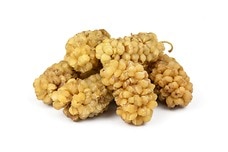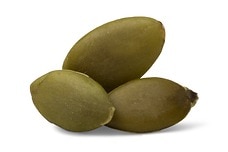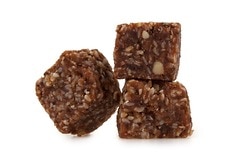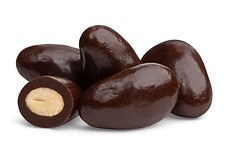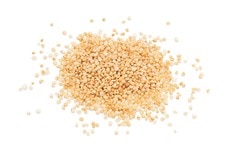Food & Snack Sources of Iron
For nearly nine decades, Popeye the Sailor has been gleaning near-superhuman strength simply by popping the lid off a can of spinach and swallowing its contents; but it's not the fiber content of the leafy green that gives Popeye his strength – it's iron, an essential mineral that helps deliver oxygen to every cell of the body (Wax, 2015).
Of course, spinach does contain iron; but it contains far less iron than many other foods, including nuts, seeds and dried fruits. So why does Popeye eat so much spinach? Turns out an early report on the iron content of spinach had a calculation error that reported the iron content to be 10 times the actual amount – and the error wasn't detected for almost 40 years, nearly a decade after Popeye was introduced. By then, the reputation of spinach as one of the top sources of iron was pretty well-established; and it's an image that's persisted to some degree ever since. Does that mean you shouldn't include spinach in an iron-rich diet? Not at all – but there are other sources of iron that are both tastier and more convenient.
So - Why is Iron So Important?
Iron is essential to the production of healthy red blood cells, which carry life-giving oxygen to every cell in your body (Wax, 2015). When iron levels are low, your organs and other tissues may be deprived of the oxygen they need to function optimally, or even normally, leaving you at risk for diseases and medical issues like fatigue and weakness.
Low levels of iron cause a condition called anemia, which is characterized by symptoms like dizziness, fatigue, headaches, problems breathing and an increased sensitivity to cold temperatures. Although anyone can develop anemia, there are certain groups at greater risk, including:
- women of childbearing years, due to menstruation or childbirth
- people over the age of 65
- people who take blood thinners, including aspirin
- people with medical conditions that interfere with iron absorption
- people with kidney failure
- people with poor diets
Some types of cancer, as well as ulcers, can also cause anemia from chronic blood loss (Cleveland Clinic, 2014).
Foods Rich in Iron to Add to Your Diet
There are two “types” of dietary iron: heme iron that comes from animal sources like liver, oysters, clams, eggs and red meat and non-heme iron that comes from plant sources, like dried fruits, nuts, seeds, beans and whole grains. While eating a healthy, balanced diet is important to ensure you get as many beneficial nutrients as possible, sometimes your iron levels need a boost.
What is important to know is that nonheme iron isn’t as bioavailable as heme iron. In fact, the iron needs of vegetarians are 1.8 times higher than for those who eat meat to adjust for the bioavailability. When you combine sources of non-heme iron with heme sources, the absorption of the plant-based non-heme iron is increased (National Institutes of Health [NIH], 2016).
One of the simplest ways to increase your levels of iron is with high-iron snacks that can be incorporated into your daily routine. Dried fruits like raisins, apricots and prunes are among the best sources of non-heme iron, followed by nuts like almonds and Brazil nuts (Wax, 2015). Combine more than one source into a make-your-own trail mix or buy a trail mix already prepared and keep some on-hand at work to give you a midday boost of healthy energy.
The best natural sources of iron in food include (Wessling-Resnick, 2009):
- Beef (2.3 mg iron per 3-ounce serving)
- Dark meat of chicken (1.13 mg iron per 3-ounce serving)
- Bran cereal (5.8 to 18 mg iron per cup)
- Raisins (0.8 mg iron in a 1.5-ounce serving)
- Kidney beans (1.97 mg iron per ½ cup)
- Prunes (0.45 mg iron in five prunes)
- Cashew nuts (1.89 mg iron per ounce)
Are You Getting Enough Iron?
The amount of iron you need in your daily diet changes based on your age, gender and other factors. Ideally, women from 19 to 50 years of age need about 18 mg of iron each day, while men of the same ages need about 8 mg daily. Once women enter menopause, their need also drops to about 8 mg per day. Boys from age 14 to age 18 need about 11 mg per day, while girls of the same age group need about 15 mg daily. Pregnancy increases the recommended Daily Value (DV) for iron to 27 mg per day, regardless of age. See the below chart for more specifics on how much iron is recommended! (NIH, 2016).
When it comes to iron, it's important to get enough – but you don't want to overdo it, either. Too much iron can result in problems like dizziness, nausea, vomiting, and headache (Wax, 2015). Overdosing on iron is associated primarily with taking too many iron supplements, which is one more reason why it's important to get your recommended amount of iron from your food and to not rely on iron supplements (NIH 2016).
To be extra safe, try getting extra iron through plant sources instead of meats. Why? Because non-animal sources of iron like the kind found in fruits and nuts is absorbed at a different rate, which reduces the risk of overloading your system with too much iron if you add plant-based iron-rich snacks to your diet.
Table 1: Recommended Dietary Allowances (RDAs) for Iron (U.S. Food and Drug Administration, 2015)
| Age | Male | Female | Pregnant | Lactating |
|---|---|---|---|---|
| 0-6 months | 0.27 mg* | 200 mg | ||
| 7-12 months | 11 mg | 260 mg | ||
| 1-3 years | 7 mg | 700 mg | ||
| 4-8 years | 10 mg | 1,000 mg | ||
| 9-13 years | 8 mg | 1,300 mg | ||
| 14-18 years | 11 mg | 1,300 mg | 27 mg | 10 mg |
| 19-50 years | 8 mg | 180 mg | 27 mg | 9 mg |
| 51+ years | 8 mg | 8 mg |
Iron-Rich Recipes
Adding iron to your diet doesn\'t mean chugging down endless cans of spinach; there are plenty of iron-rich snacks like nuts and dried fruits that can help you improve your health and wellness without sacrificing flavor - no matter what Popeye says. So check out some of our top recipes for foods full of the mineral, as formulated by our Health Nut and Registered Dietitian.
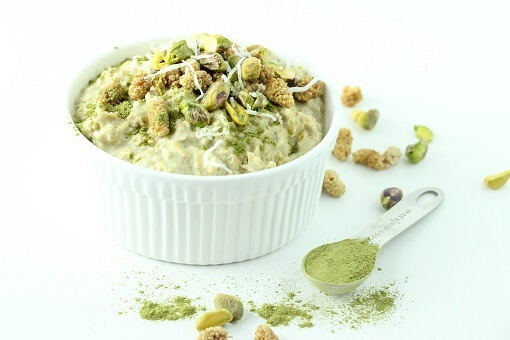
Moringa Oatmeal Recipe
Get your iron in early with this wholesome combination of whole grains, nuts, fruit, and superfood powders. Enjoy the great taste of oatmeal with this redolent recipe today!
Ingredients: Gluten-free rolled oats, almond milk, agave or maple syrup, vanilla extract, moringa powder, pistachios, dried mulberries, unsweetened shredded coconut, chia seeds.
Total Time: 10 minutes
| Yield: 4 servings
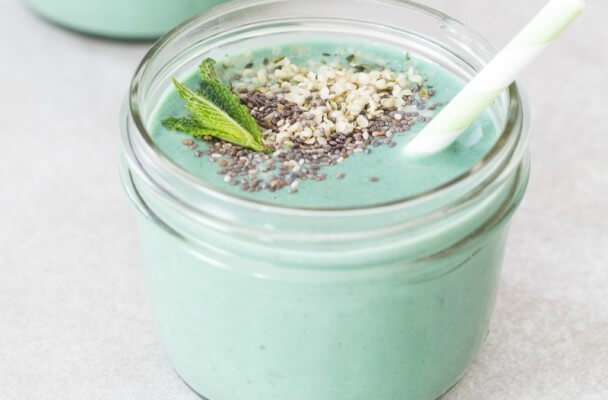
Protein-Packed Detox Smoothie Recipe {vegan}
An abundant source of all the nutrients you need, this scrumptious smoothie supplies a healthy helping of the essential mineral in addition to a beverage that’s as delicious as it is nutritious!
Ingredients: Almond milk, frozen banana, spirulina, hemp protein powder (optional), fresh mint, chia seeds, hemp hearts.
Total Time: 5 minutes
| Yield: 2 servings
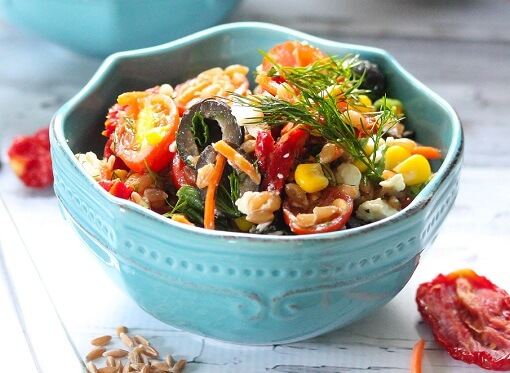
Farro Vegetable Salad Recipe
A perfect selection for a lunch or side dish, this palatable plate dispenses a delightful blend of fresh veggies and whole grains. For an offering of iron that also tastes great, try this simple salad today!
Ingredients: Organic farro, sun dried tomatoes, frozen corn (thawed), scallions, black olives, feta cheese, cherry tomatoes, shredded carrots, salt, fresh dill, fresh mint, extra virgin olive oil, balsamic vinegar.
Total Time: 1 hour
| Yield: 6 servings
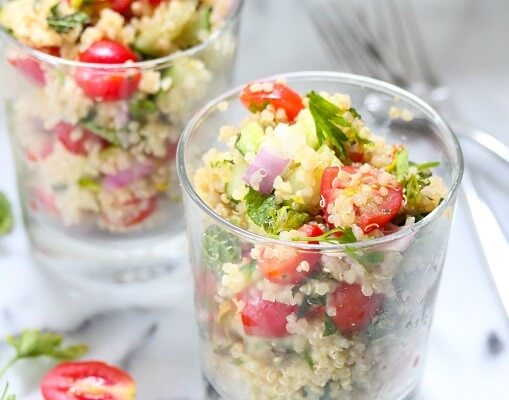
Quinoa Tabbouleh Salad Recipe {gluten-free}
This delectable dish supplies an unbeatable source of iron with a whopping 88% of the DV for the mineral. The recipe is also a staple of Mediterranean cuisine, so you know it tastes as good as it looks!
Ingredients: Quinoa, cherry tomatoes, red onion, cucumber, extra virgin olive oil, balsamic vinegar, fresh parsley, fresh mint, black pepper, salt.
Total Time: 40 minutes
| Yield: 4 servings
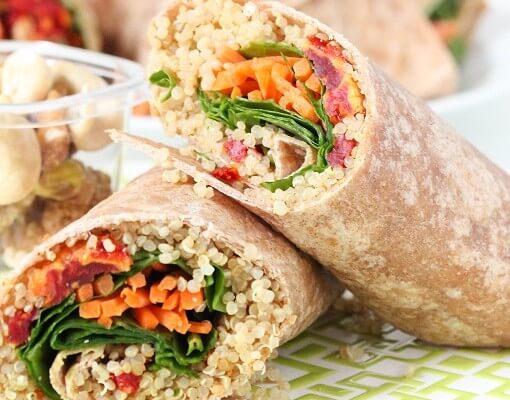
Quinoa Veggie Wrap Recipe {vegan}
As a flavorful finger food, simple snack, or light lunch- these toothsome collations offer an impressive 70% of the DV for iron with an impressive nutrient profile that doesn’t end there. Enjoy all these wraps have to offer and try this recipe today!
Ingredients: Tortilla wraps, quinoa, hummus, fresh spinach, sun-tomatoes, shredded carrots.
Total Time: 30 minutes
| Yield: 4 wraps
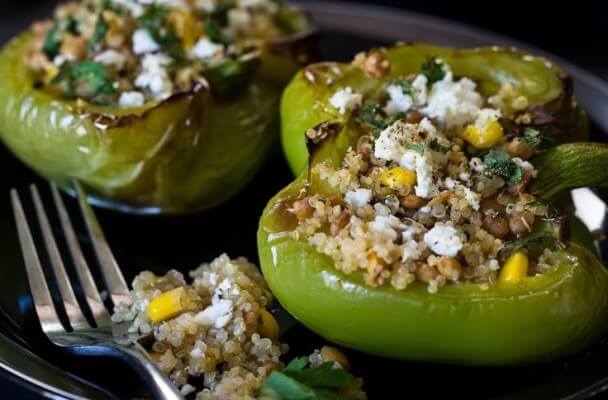
Quinoa Stuffed Peppers Recipe {gluten-free}
A delightful dish for an undemanding dinner, these stuffed peppers can also be cut up and served as a pleasant party favor. Enjoy the piquant relish of this recipe at your next celebration!
Ingredients: Quinoa, green bell peppers, canned lentils, fresh spinach, feta cheese, frozen corn (thawed), salt, black pepper.
Total Time: 40 minutes
| Yield: 6 servings (8 half-peppers)
Our Recommended Snack Sources of Iron
Discover easy ways to add iron to your diet with these snack selections from our Health Nut and Registered Dietitian.
Healthy Eating
- Healthy Highlights
- 5 Uses for Cacao Powder
- 5 Ways to Eat Farro
- 6 Best Gluten-Free Foods
- Alcohol and the Body
- Almond Flour Recipes
- Anti-Aging Superfoods
- Beat the Afternoon Slump
- Benefits of a Plant-Based Diet
- Benefits of Baobab
- Benefits of Cashews
- Benefits of Coconut Oil for Hair
- Benefits of Coconuts
- Benefits of Dates
- Benefits of Fenugreek
- Benefits of Garcinia Cambogia
- Benefits of Goji Berries
- Benefits of Kale Chips
- Benefits of Monk Fruit Sweetener
- Benefits of Peanuts
- Benefits of Pecans
- Benefits of Pistachios
- Benefits of Pumpkin Seeds
- Benefits of Spelt Flour
- Benefits of Steel Cut Oats
- Benefits of Sunflower Seeds
- Benefits of Tiger Nuts
- Benefits of Turmeric
- Benefits of Walnuts
- Benefits of Wheatgrass
- Best Food Fads
- Cacao vs Cocoa
- Caffeine-Free Energy Foods
- Chocolate That's Good for You
- Diet vs. Exercise
- Fat Burning Foods
- Food Myths Debunked
- Foods for Bone Density
- Foods for Colon Health
- Foods for Healthy Hair
- Foods for Healthy Skin
- Foods to Help Sleep
- Foods to Reduce Stress
- Green Tea Benefits
- Healthy Baking Flours
- Heart Healthy Habits
- High Protein Health Risks
- How to Boost Your Metabolism
- How to Lose Weight While Aging
- How to Throw a Vegan BBQ
- Kaniwa vs Quinoa
- Little Health Foods
- Low-Carb: Fad or Friend?
- Making Healthier Desserts
- Mediterranean Diet Meal Plan
- Natural Beauty Products
- Nuts for Weight Loss
- Preparing Vegan Meals
- Preventing Muscle Degeneration
- Rare Superfoods
- Reduce Sugar Intake
- Save Time By Going Vegan
- Smarter Snack Swaps
- Smoothie Ingredients
- Soy Protein vs Whey Protein
- Starting a Plant-Based Diet
- Steel Cut vs Rolled Oats
- Sugar Substitutes
- Vegan Proteins
- Vegan Substitutions for Fall Recipes
- Why Go Vegan
- Healthy Meals
- Healthy Recipes
- Sports Nutrition
- Nutrition and Special Diets
- 21 Day Fix
- 5 Popular Diet Similarities
- Alkaline Diet
- Anti-Inflammatory Diet
- Calorie Counting
- Carb Cycling Diet
- Celiac Disease
- Cholesterol
- Clean Eating
- Crohn's Disease
- DASH Diet
- Detox Diet
- Diabetes
- Diabetes Diet
- Diet Pill Dangers
- Fat Burning Foods
- Gluten-free Diet
- Glycemic Index
- Heart Health
- High Blood Pressure Diet
- High Fiber Foods
- How to Eat Healthy
- How to Lower Blood Pressure
- Hypertension
- IBS Diet
- Ketogenic Diet
- Liquid Diet
- Low GI Foods
- Low-Carb Diet and Foods
- Low-Fat High-Carb Diet
- Mediterranean Diet
- Mediterranean Diet Foods
- Military Diet
- Nutrition Labels Explained
- Paleo Diet
- Raw Food Diet
- Superfoods
- Sustainable Weight Loss
- Thrive Diet
- Vegan Diet
- Vegetarian Diet
- Weight Loss Shakes
- Whole30
- Vitamins, Minerals & Nutrients


